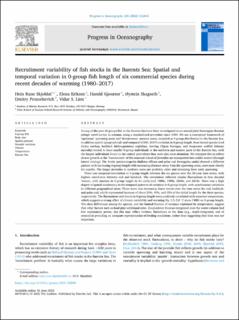Recruitment variability of fish stocks in the Barents Sea: Spatial and temporal variation in 0-group fish length of six commercial species during recent decades of warming (1980–2017)
Skjoldal, Hein Rune; Eriksen, Elena; Gjøsæter, Harald; Skagseth, Øystein; Prozorkevich, Dmitry A.; Lien, Vidar Surén
Peer reviewed, Journal article
Published version
Permanent lenke
https://hdl.handle.net/11250/3000083Utgivelsesdato
2022Metadata
Vis full innførselSamlinger
- Articles [3012]
- Publikasjoner fra CRIStin [3066]
Originalversjon
https://doi.org/10.1016/j.pocean.2022.102845Sammendrag
Young-of-the-year (0-group) fish in the Barents Sea have been investigated in an annual joint Norwegian-Russian pelagic trawl survey in autumn, using a standardized procedure since 1980. We use a conceptual framework of ‘upstream’ spawning areas and ‘downstream’ nursery areas, recorded as 0-group distribution in the Barents Sea, to address spatial (geographical) and temporal (1980–2017) variation in 0-group length. Four boreal species (cod Gadus morhua, haddock Melanogrammus aeglefinus, herring Clupea harengus, and deepwater redfish Sebastes mentella) tended to have smaller 0-group individuals in the northern and eastern parts of the Barents Sea, with the largest individuals found in the central part where they were also most abundant. We interpret this to reflect slower growth as the ‘fore-runners’ of the seasonal cohort of juveniles are transported into colder waters (through lateral mixing). The Arctic species (capelin Mallotus villosus and polar cod Boreogadus saida) showed a different pattern with increasing 0-group length with increasing distance away from the spawning areas, seen most clearly for capelin. The longer juveniles in northern areas are probably older and stemming from early spawning.
